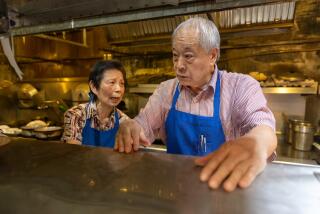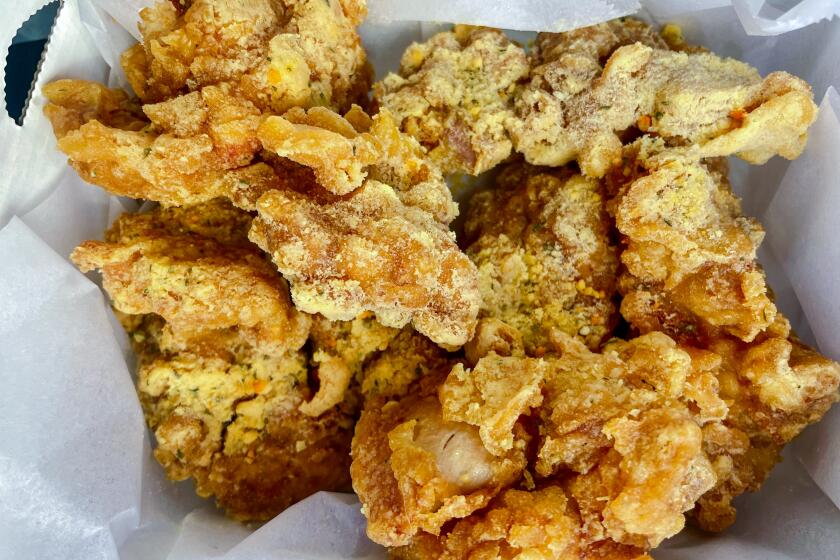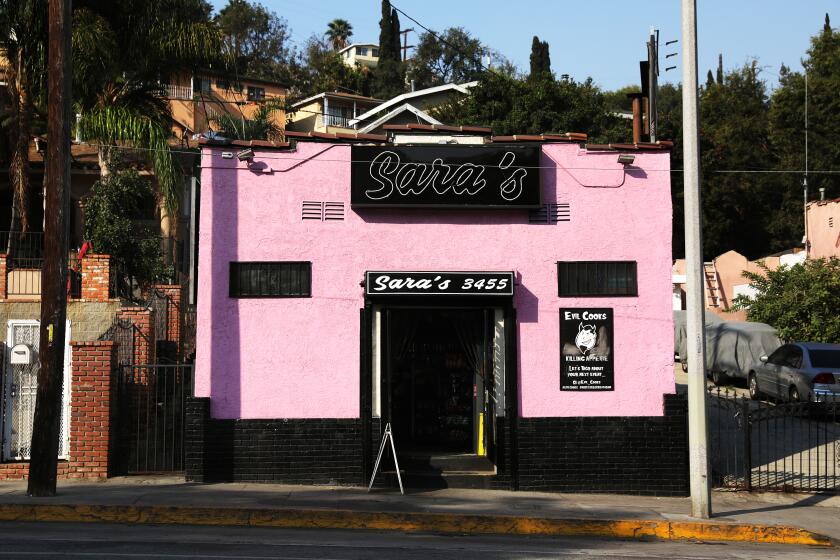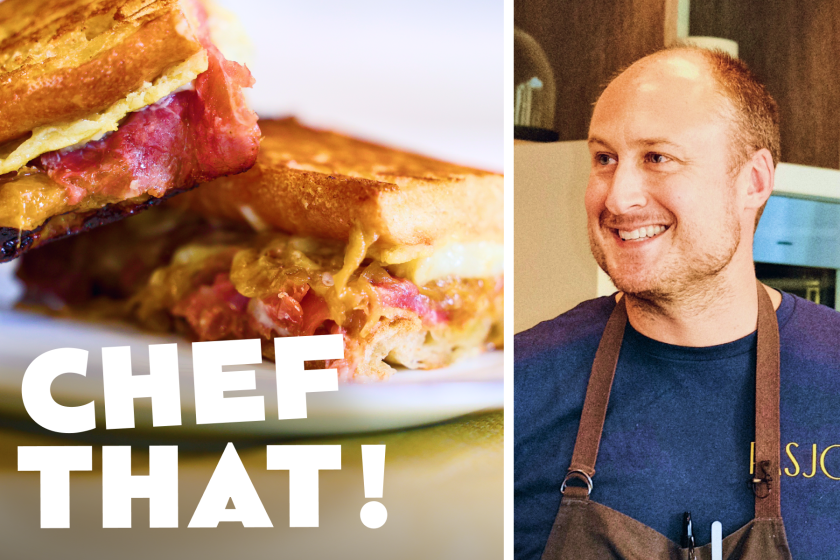Empress Pavilion 1989: When the dim sum was better than in Hong Kong, moo shu was a ‘burrito’
When Empress Pavilion, a 25-year-old dim sum restaurant in Chinatown, announced it was being evicted, the reaction included plenty of nostalgia. Many Angelenos recalled marking life’s successful moments and celebrating holidays in the 600-capacity dining room.
Below is the original L.A. Times review of the restaurant, published July 6, 1989. You’ll see that Bamboo Plaza was still shiny and new, shark fin soup was not too contentious and prawns with honey-glazed walnuts was a novelty.
Empress Pavilion: A New Direction in Chinatown
By Barbara Hansen
The opening of the Empress Pavilion shows that big things are happening in Chinatown. And this restaurant is really big. It can seat 600 for dim sum, has 14 kitchen chefs, two barbecue chefs and a dim sum crew of 15.
Carts laden with tempting snacks roll through the huge room from 9 a.m. (8 a.m. on weekends) until mid-afternoon. Then it’s time to prepare for dinner, which is no small project considering the 175-item menu.
For years, a market called Yee Sing Chong and a parking lot occupied this site. They’ve been replaced by the bulky, brand new Bamboo Plaza, which includes a parking structure, a market that opened last week, spaces promised to several eating places and, on the second level, the Empress Pavilion.
The restaurant departs from the old Chinatown tradition of ornate carvings, gilt dragons and red plush. It’s a serene room with clean, simple lines, pale, pink-tinged walls, a burgundy print carpet and touches of aqua in the recessed ceiling and chairs.
A New Direction
The kitchen goes in new directions too. Witness such dim sum as shrimp mousse wrapped in fine strands of potato and then deep-fried so that it looks like a tiny curly porcupine. Or shrimp in a translucent wrapper with a thick band of mashed taro around its waist, like a life preserver. Or a morsel of beef wrapped in a thin sheet of pineapple. Or shrimp rolled in mango and accompanied by thick, sweet, yellow mayonnaise.
Most of these ideas work well. But the chunk of beef in pineapple was too heavy for the delicate, salad-like presentation. And thin slices of veal wrapped around enoki mushrooms were dry and chewy rather than “tender,” as the menu promised. The veal appears in a list of “gourmet selections” on the dinner menu. A companion dish, sauteed prawns with honey-glazed walnuts, succeeds or fails depending upon whether one likes the surprising sauce--mayonnaise blended with Thousand Island dressing.
An appetizer in a similar vein, served at the restaurant’s grand opening party last week, featured mayonnaise-coated shrimp belted with a longan and impaled on a pick with a strawberry slice. This combination of meat and fruit is summer food. There will be sturdier fare in winter.
The Empress Pavilion is a serious, Hong Kong-style restaurant, aiming at top level food and service. Executive chef Yiu Leung worked in Hong Kong for 20 years. Manager Jimmy P. Y. Chiu was once assistant manager at the Jade Garden in Star House, Hong Kong, a restaurant that also yielded the chief prep chef, Wing Kai So.
Rich-Tasting Catfish
The kitchen can turn out superlative food. At dinner one night, we had a clay pot of rich-tasting catfish with toasty whole garlic cloves, stir-fried asparagus as perfect as it was simple, and wonderful braised E-Fu noodles that were embellished only with straw mushrooms and thin yellow Chinese chives.
My Chinese companions liked the poached chicken with Chinese ham, although the meat was a bit sturdy, as one might expect from an American-bred bird. And the shark’s fin soup with crab would have been excellent if the crab hadn’t added an unwelcome strong flavor. We followed that with large scallops stuffed with shrimp mousse that were presented one to a customer.
But my heart belongs to the dim sum. There are at least 60 varieties, and they’re as good, sometimes better, than those in Hong Kong. Here, fried water-chestnut cakes are sweet and fresh. When I had them in Hong Kong recently, they tasted of everything else that had been cooked in the oil.
The familiar barbecued pork buns, shrimp dumplings, beef balls and egg tarts are available. If you’re willing to advance beyond these, try a thick rice noodle that is embedded with dried shrimp and green onions, fried until slightly crusty and topped with hoisin sauce and sesame seeds. Bird’s nest dumplings come in a bowl of velvety broth. Chiu Chow-style fun gor, a steamed dumpling, contains preserved vegetable, meat and tiny shrimp. And stuffed squash is glorious when it is bright green mo gwa cut into circles, filled with shrimp, pork and mushrooms and topped with dried scallops, cilantro and a bit of salted egg yolk.
The dim sum menu includes several rice and noodle dishes. The top-of-the-line Empress Pavilion pan-fried noodles are covered with shrimp, fish, squid and scallops, each beautifully succulent. The popular Singapore-style, curry-flavored, fried rice noodles become Fukien-style rice noodles when the curry powder is eliminated.
Bowlful of Tofu
Then there are the sweets, among them hot tapioca pudding flavored with coconut; cool, fruit-topped mango pudding; a steamed cake with glaringly yellow egg filling, and an absolutely marvelous bowlful of hot fresh tofu in brown sugar syrup.
At night, double-boiled milk pudding turns into Chinese-style creme brulee, even though this airy concoction of egg whites, milk, syrup and ginger juice has no browned sugar crust. Perhaps the name change is aimed at customers new to Chinese food, who will also appreciate the two set dinners that end with fortune cookies and the explanation of moo shu pork as “burrito a la Chinois.”
More to Read
Eat your way across L.A.
Get our weekly Tasting Notes newsletter for reviews, news and more.
You may occasionally receive promotional content from the Los Angeles Times.










